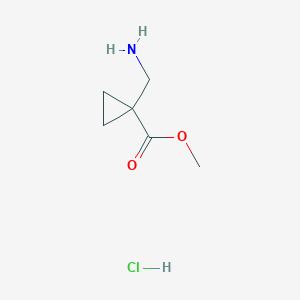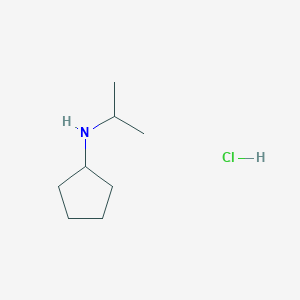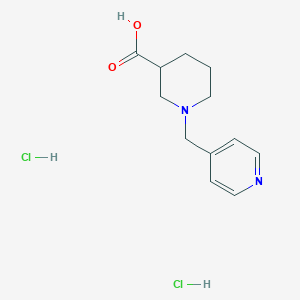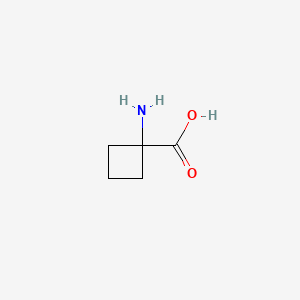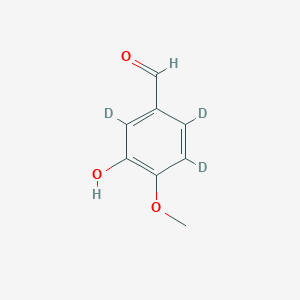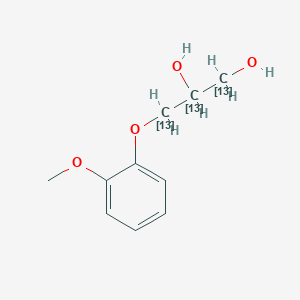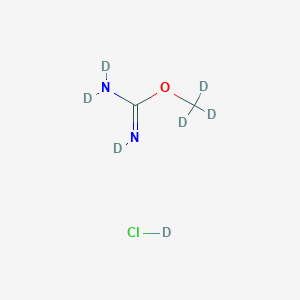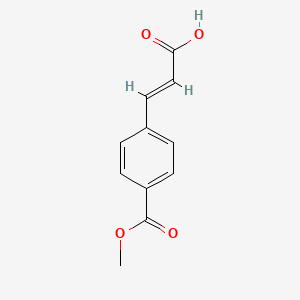![molecular formula C15H12N2O B3417935 5H-Dibenzo[b,f]azepine-5-(~13~C,~15~N)carboxamide CAS No. 1173022-00-8](/img/structure/B3417935.png)
5H-Dibenzo[b,f]azepine-5-(~13~C,~15~N)carboxamide
Overview
Description
5H-Dibenzo[b,f]azepine-5-(~13~C,~15~N)carboxamide: is a tricyclic compound with a seven-membered ring structure.
Preparation Methods
Synthetic Routes and Reaction Conditions:
Starting Material: The synthesis begins with 5H-Dibenzo[b,f]azepine.
Reaction with Cyanate Salt: The compound is reacted with a cyanate salt, such as alkali metal cyanate salts or alkaline-earth metal cyanate salts.
Purification: The resulting product is purified using methods like chromatography.
Industrial Production Methods: The industrial production of 5H-Dibenzo[b,f]azepine-5-(~13~C,~15~N)carboxamide involves large-scale synthesis using similar reaction conditions but optimized for higher yields and purity. The use of automated reactors and continuous flow systems is common to ensure consistent quality and efficiency .
Chemical Reactions Analysis
Types of Reactions:
Oxidation: The compound can undergo oxidation reactions to form various oxidized derivatives.
Reduction: Reduction reactions can convert it into different reduced forms.
Substitution: It can participate in substitution reactions, where functional groups are replaced with others.
Common Reagents and Conditions:
Oxidation: Common oxidizing agents include potassium permanganate and hydrogen peroxide.
Reduction: Reducing agents like lithium aluminum hydride and sodium borohydride are used.
Substitution: Reagents such as halogens and alkylating agents are employed.
Major Products:
Oxidized Derivatives: These include various carboxylated and hydroxylated forms.
Reduced Forms: These include hydrogenated derivatives.
Substituted Products: These include halogenated and alkylated derivatives.
Scientific Research Applications
Chemistry:
- Used as a starting material to prepare dibenzoazepine-pyridazine derivatives .
- Synthesis of key intermediates for aminophenol derivatives .
Biology:
Medicine:
Industry:
Mechanism of Action
Comparison with Similar Compounds
10,11-Dihydro-5H-dibenzo[b,f]azepine:
Carbamazepine: A well-known anticonvulsant drug with a similar structure.
Oxcarbazepine: Another anticonvulsant with a similar core structure.
Uniqueness:
Properties
IUPAC Name |
benzo[b][1]benzazepine-11-(15N)carboxamide | |
|---|---|---|
| Details | Computed by Lexichem TK 2.7.0 (PubChem release 2021.05.07) | |
| Source | PubChem | |
| URL | https://pubchem.ncbi.nlm.nih.gov | |
| Description | Data deposited in or computed by PubChem | |
InChI |
InChI=1S/C15H12N2O/c16-15(18)17-13-7-3-1-5-11(13)9-10-12-6-2-4-8-14(12)17/h1-10H,(H2,16,18)/i15+1,16+1 | |
| Details | Computed by InChI 1.0.6 (PubChem release 2021.05.07) | |
| Source | PubChem | |
| URL | https://pubchem.ncbi.nlm.nih.gov | |
| Description | Data deposited in or computed by PubChem | |
InChI Key |
FFGPTBGBLSHEPO-IIJSWMDNSA-N | |
| Details | Computed by InChI 1.0.6 (PubChem release 2021.05.07) | |
| Source | PubChem | |
| URL | https://pubchem.ncbi.nlm.nih.gov | |
| Description | Data deposited in or computed by PubChem | |
Canonical SMILES |
C1=CC=C2C(=C1)C=CC3=CC=CC=C3N2C(=O)N | |
| Details | Computed by OEChem 2.3.0 (PubChem release 2021.05.07) | |
| Source | PubChem | |
| URL | https://pubchem.ncbi.nlm.nih.gov | |
| Description | Data deposited in or computed by PubChem | |
Isomeric SMILES |
C1=CC=C2C(=C1)C=CC3=CC=CC=C3N2[13C](=O)[15NH2] | |
| Details | Computed by OEChem 2.3.0 (PubChem release 2021.05.07) | |
| Source | PubChem | |
| URL | https://pubchem.ncbi.nlm.nih.gov | |
| Description | Data deposited in or computed by PubChem | |
Molecular Formula |
C15H12N2O | |
| Details | Computed by PubChem 2.1 (PubChem release 2021.05.07) | |
| Source | PubChem | |
| URL | https://pubchem.ncbi.nlm.nih.gov | |
| Description | Data deposited in or computed by PubChem | |
DSSTOX Substance ID |
DTXSID30678690 | |
| Record name | 5H-Dibenzo[b,f]azepine-5-(~13~C,~15~N)carboxamide | |
| Source | EPA DSSTox | |
| URL | https://comptox.epa.gov/dashboard/DTXSID30678690 | |
| Description | DSSTox provides a high quality public chemistry resource for supporting improved predictive toxicology. | |
Molecular Weight |
238.25 g/mol | |
| Details | Computed by PubChem 2.1 (PubChem release 2021.05.07) | |
| Source | PubChem | |
| URL | https://pubchem.ncbi.nlm.nih.gov | |
| Description | Data deposited in or computed by PubChem | |
CAS No. |
1173022-00-8 | |
| Record name | 5H-Dibenzo[b,f]azepine-5-(~13~C,~15~N)carboxamide | |
| Source | EPA DSSTox | |
| URL | https://comptox.epa.gov/dashboard/DTXSID30678690 | |
| Description | DSSTox provides a high quality public chemistry resource for supporting improved predictive toxicology. | |
| Record name | 1173022-00-8 | |
| Source | European Chemicals Agency (ECHA) | |
| URL | https://echa.europa.eu/information-on-chemicals | |
| Description | The European Chemicals Agency (ECHA) is an agency of the European Union which is the driving force among regulatory authorities in implementing the EU's groundbreaking chemicals legislation for the benefit of human health and the environment as well as for innovation and competitiveness. | |
| Explanation | Use of the information, documents and data from the ECHA website is subject to the terms and conditions of this Legal Notice, and subject to other binding limitations provided for under applicable law, the information, documents and data made available on the ECHA website may be reproduced, distributed and/or used, totally or in part, for non-commercial purposes provided that ECHA is acknowledged as the source: "Source: European Chemicals Agency, http://echa.europa.eu/". Such acknowledgement must be included in each copy of the material. ECHA permits and encourages organisations and individuals to create links to the ECHA website under the following cumulative conditions: Links can only be made to webpages that provide a link to the Legal Notice page. | |
Synthesis routes and methods I
Procedure details







Synthesis routes and methods II
Procedure details





Synthesis routes and methods III
Procedure details





Synthesis routes and methods IV
Procedure details





Synthesis routes and methods V
Procedure details





Retrosynthesis Analysis
AI-Powered Synthesis Planning: Our tool employs the Template_relevance Pistachio, Template_relevance Bkms_metabolic, Template_relevance Pistachio_ringbreaker, Template_relevance Reaxys, Template_relevance Reaxys_biocatalysis model, leveraging a vast database of chemical reactions to predict feasible synthetic routes.
One-Step Synthesis Focus: Specifically designed for one-step synthesis, it provides concise and direct routes for your target compounds, streamlining the synthesis process.
Accurate Predictions: Utilizing the extensive PISTACHIO, BKMS_METABOLIC, PISTACHIO_RINGBREAKER, REAXYS, REAXYS_BIOCATALYSIS database, our tool offers high-accuracy predictions, reflecting the latest in chemical research and data.
Strategy Settings
| Precursor scoring | Relevance Heuristic |
|---|---|
| Min. plausibility | 0.01 |
| Model | Template_relevance |
| Template Set | Pistachio/Bkms_metabolic/Pistachio_ringbreaker/Reaxys/Reaxys_biocatalysis |
| Top-N result to add to graph | 6 |
Feasible Synthetic Routes
Disclaimer and Information on In-Vitro Research Products
Please be aware that all articles and product information presented on BenchChem are intended solely for informational purposes. The products available for purchase on BenchChem are specifically designed for in-vitro studies, which are conducted outside of living organisms. In-vitro studies, derived from the Latin term "in glass," involve experiments performed in controlled laboratory settings using cells or tissues. It is important to note that these products are not categorized as medicines or drugs, and they have not received approval from the FDA for the prevention, treatment, or cure of any medical condition, ailment, or disease. We must emphasize that any form of bodily introduction of these products into humans or animals is strictly prohibited by law. It is essential to adhere to these guidelines to ensure compliance with legal and ethical standards in research and experimentation.

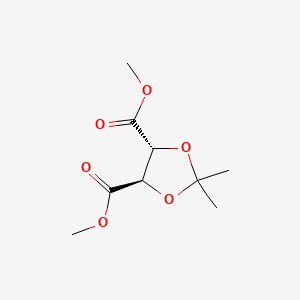
![3-Boc-3-azabicyclo[3.1.0]hexane-1-carboxylic acid](/img/structure/B3417872.png)
